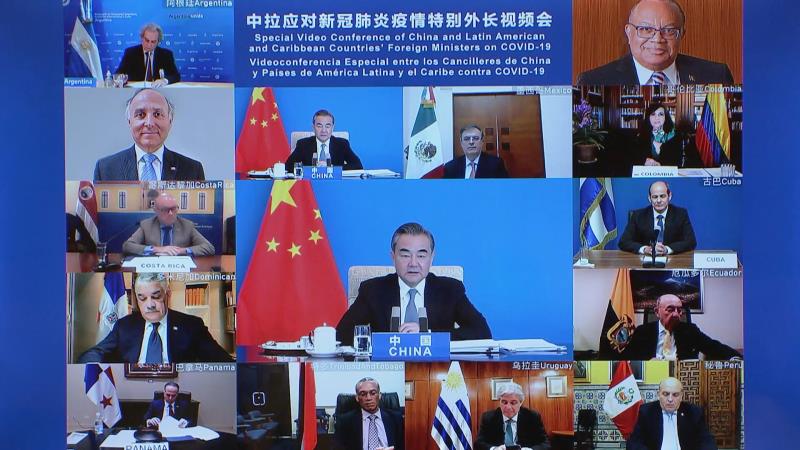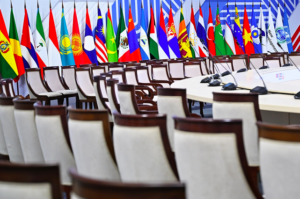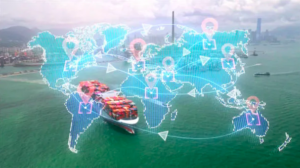The rise of China resulted in Latin America strengthening ties with the Asian giant, as a result of the complementarity in both foreign and economic policy between both actors. There are similar visions about what the international order should be like, while the Chinese economy needs food and energy that can be provided by Latin America. For its part, China has a capital surplus and industrial overcapacity, of which the subcontinent lacks. The economic reality shows insufficient industrial development and dependence on the primary sector of most Latin American economies, which –although they are desirable to correct- explain the aforementioned complementarity.
But China’s influence on the subcontinent is not just economic, as Beijing is also seeking adherence to the Belt and Road Initiative and adoption of its 5G and nuclear technologies. These developments have profound strategic influence, thereby affect the interests of the United States.
Because of this growing multidimensional Sino-Latin American relationship, the strategic dispute between Washington and Beijing has spread to Latin America. In October 2018, US Secretary of State Mike Pompeo warned of the “dangers” of China’s expansion in the region, calling it “predatory economic activity“. It should be remembered that Washington in recent decades paid little attention to Latin America and, therefore, gradually lost its presence in the region. Through protectionist policies and the delay of trade agreements, the White House made it easier for not only China but also the European Union to take the lead in terms of agreements with the subcontinent.
Sino-Latin American relations before the Covid-19 outbreak
Total trade between China and Latin America boosted from US$ 17 billion in 2002 to nearly US$ 315 billion in 2019. In 2015, President Xi Jinping set a goal to increase total bilateral trade to US$ 500 billion in ten years. China’s purchases of goods from Latin America and the Caribbean amounted to nearly US$ 165 billion in 2019, representing almost 8% of China’s total imports.
Chinese exports to the region in 2019 increased to US$ 142 billion, which represented 6% of China’s total sales. The People’s Republic of China has become the second trading partner of most Latin American countries and – in the cases of Brazil, Argentina, Chile and Peru – it has surpassed the US in that ranking (achieving the first place).
China’s investments in Latin America and the Caribbean during the period 2005-2019 amounted to US$ 130 billion. Projects in the energy sector accounted for 56% of all investments, while those for metals and mining accounted for 28%. Chinese investment in construction projects in the region reached the figure of US$ 61 billion, which was allocated to infrastructure for energy by 53% and for transportation by 27%.
In terms of finance, PRC organizations such as the New Development Bank and the Export-Import Bank have become the largest lenders in Latin American countries. Accumulated loans totaled US$ 137 billion between 2005 and 2019, with Venezuela, Brazil, Ecuador and Argentina being the main recipients. Most of the loans (67%) have been for energy projects, while 20% have been for infrastructure projects. These loans from China to the subcontinent have exceeded the figures offered by the World Bank and the Inter-American Development Bank, allowing access to financing to governments with scarce reserves and highly indebted, which must face a series of social demands.
This growing economic relationship is strengthened by the accession of nineteen Latin American countries to the Belt and Road Initiative (BRI). It should be recalled that the opening of the initiative to other regions such as Latin America was announced at the First Belt and Road Forum for International Cooperation in May 2017. And Panama was the first country in the region to sign the agreement in November 2017. Until March 2020, countries such as Brazil, Mexico, Colombia and Argentina had not yet signed a document of accession (even though, by late September, it was officially stated that Argentina is going to join).
The US government has tried to dissuade certain Latin American governments from participating in the BRI: in a visit to Panama, US Secretary of State Mike Pompeo asked the subcontinent to “keep your eyes open to the increase of Chinese investments”. In turn, on his tour of the region in April 2019, Pompeo said that Washington “will always encourage its Latin American partners to avoid these agreements that lead to the debt trap“.
China’s relations with Latin America during the pandemic
Since March of this year, most Latin American nations have received help from China to face the Covid-19 pandemic, in health and medical matters, in the form of equipment or advice. The PRC has stood out in the concert of nations for the cooperation provided, despite the fact that some analysts in the West have expressed that Beijing used its health experience and medical equipment as tools of soft power in Latin America, developing a “mask diplomacy”. China has rebutted this concept by using the term “construction of a Silk Road of Health“.
Due to the proactive role of Beijing in providing aid, the pandemic has stimulated reflection on China’s position on the international stage. Such proactive role of the PRC had an impact on Latin American countries, which – by geographical location, history and political culture – are part of Washington’s sphere of influence. For Latin American countries, the 2020 pandemic showed an absent US, oblivious to its cooperation programs in the past, while China was standing by with various forms of closeness and cooperation.
The PRC’s relationship with Latin America in recent months has shown that distance is no longer a major obstacle. And in this context, it is worth highlighting two phenomena registered since the impact of the pandemic became strong in this region: 1) the use of digital platforms to organize meetings; and 2) the development of various air bridges, both from Mexico and from South America.
Regarding the first phenomenon, the People’s Daily reported: “Under the special background of the epidemic, President Xi Jinping has maintained close contact and communication with the leaders of many Latin American countries, including Brazil, Argentina, Cuba, Mexico, Chile and Venezuela among others, which has consolidated the basis for the development of relations between China and Latin America under the new situation and illuminated the way towards future relations”.
Other examples of the videoconferences are the events organized between the Community of Latin American and Caribbean States (CELAC) and China, such as the meeting held on March 24 with the vice president of the PRC´s Commission for Health Service. Within this framework, there was a special meeting called by the Minister of Foreign Affairs of China, Wang Yi, and his Mexican counterpart, Marcelo Ebrand (in his capacity of CELAC Chair during this year). The participating foreign ministers held a special session of the China-CELAC Forum via Zoom, where they gave an account of how each country was facing the pandemic, as well as the vision they had about the economic reality that is coming for the region.
Minister Wang said that the vaccine under development in his country “will be a public good with universal access and that a loan of one billion dollars will be allocated to support the access of the nations of the region to the antidote“. The ministers also expressed “their opposition to politicizing or stigmatizing the epidemic and their willingness to work together to deepen cooperation in all fields“.
It is also worth mentioning that, in the field of business, the Canton Fair was held online, attracting a large number of visitors from Latin America. Chinese companies have developed live broadcast plans for the time zones of the American continent and have showcased their products in showrooms comprehensively.
Examples of the second phenomenon, that is, the realization of air bridges, took place between the PRC and Mexico to supply supplies to Mexican hospitals, completing 45 flights by the beginning of August. In the case of Mexico, the route between the Mexican capital and Shanghai has already been established with Aeroméxico flights.
Different was the situation of the flights of LATAM and Aerolíneas Argentinas, which had never made the route to China directly. Based on the experience known as “Solidarity Plane”, LATAM landed at the airports of Shanghai, Beijing, Guangdong and Fujian, totaling 13 trips to and from Chile, an identical sum for Brazil and two flights to Peru, to bring equipment and medicines. In addition, 3 flights were made from South Korea to Colombia.
For Aerolíneas Argentinas it was also an unprecedented experience. Used to flying to Sydney in Australia, their route has always been close to the Polar Circle. This time they had to go further north, in a corridor similar to that operated by LATAM flights. On April 18, 13 tons of supplies from Shanghai arrived at Buenos Aires’ international airport. The operation was described by the Argentine authorities as “one more example of the friendship and cooperation that exists between both States“. Derived from these “air bridges“, a question is posed for the future: will it be possible to have direct commercial flights in the future between Santiago de Chile or Buenos Aires and Shanghai or Beijing?
View for the short term and final thoughts
For most Latin American countries, the two main partners are the US and China. For this year, the US economy is expected to contract 6%, while the Chinese economy would grow 2%, a precarious figure for Chinese economic levels but a positive base for reactivation in 2021.
According to figures from the Economic Commission for Latin America and the Caribbean, the subcontinent’s GDP will register a contraction of -5%, the worst drop since the 1929 crisis. Exports are also expected to plummet by 15%. The combination of slowed trade, a fall in commodity prices and a tense relationship between creditors and debtors could result in some countries in the region urgently seeking economic assistance abroad.
Despite the strong impact that Covid-19 will have on the Latin American economy, the recovery could start from trade with China, due to the reestablishment of industrial activity in that country and the continuation of its demand for products that Latin America exports. Faced with the question of whether, in the wake of the crisis, the Chinese government will continue to support the internationalization of Chinese capital with the impetus with which it has done so far, or whether the financial power of the Chinese state will be redirected towards the domestic market, it could be expected that Beijing will increase its presence in Latin America, since Chinese companies would be better positioned. This best position would be achieved by the financial support that these companies receive from the Chinese government, to expand global supply chains, acquire strategic assets that go bankrupt or buy local companies that are put up for sale.
In the current struggle between Washington and Beijing for the international hegemonic transition, they are not only competing for trade, technology and geopolitical spaces, but also for allies. For this reason, ties with China represent an increasingly sensitive diplomatic challenge for Latin American countries, considering the growing tensions between the US and the PRC.
China has more economic influence in Latin America than any other competitor to Washington in contemporary history. And the Covid-19 pandemic and its resulting health, medical and economic demands have converged with the Washington-Beijing tension registered since 2018.
Latin American governments face the challenge of facing the health and economic effects of the pandemic, to which is added the dilemma of which international position to assume, as a subcontinent located at the intersection of a road that is passed through by a hegemon that disregards relations with its neighbors and a challenging rising power.
The options available to Latin American governments are, mainly, (a) prioritize the traditional alliance with Washington, (b) make the growing ties with China prevail, (c) adopt a foreign policy equidistant from both poles, or (d) play both cards.
The next few months will show us the positions that the governments of Latin America are taking…
Picture credits: CGTN







This coronavirus pandemic is a litmus test for Latin American leadership. Poor management of the pandemic could end up having very serious political consequences for the presidents and for democracy. Yet at the same time, in those countries in which the response has been correct and timely, the presidents see their levels of support rising (Vizcarra in Peru and Bukele in El Salvador, to cite just two examples). In a second group of countries the measures adopted by the presidents have helped reduce the degree of polarization and facilitate agreements between the government and the opposition, which until recently had seemed impossible to achieve (Fernandez and the opposition in Argentina). And in a third group the pandemic could offer the governments?—if they act effectively and sensibly?—an opportunity to overcome the social and political crises they face, reconnect with the citizenry, seek agreements, and change programs (Pinera in Chile). Obviously, all these assessments can change quickly.
In Peru, in mid September, President Vizcarra was on the brink of dismissal, after Congress admitted a motion for vacancy (impeachment). By early August Peru had surpassed 20,000 deaths from COVID-19. This country (of 33 million inhabitants) is third in Latin America in positive cases and deaths from the virus, behind Brazil and Mexico.
With regards El Salvador, according to a poll published on May 24 by the Salvadoran daily La Prensa Gráfica, 92.5% approve of the work done by President Bukele during his first year in office. But the main achievement of these 12 months in office is the drastic reduction in violent deaths (4.1 homicides a day), well below the average of 12.6 that his predecessor Salvador Sánchez Cerén had in the same period. So it’s not a matter of an efficient management of the pandemics.